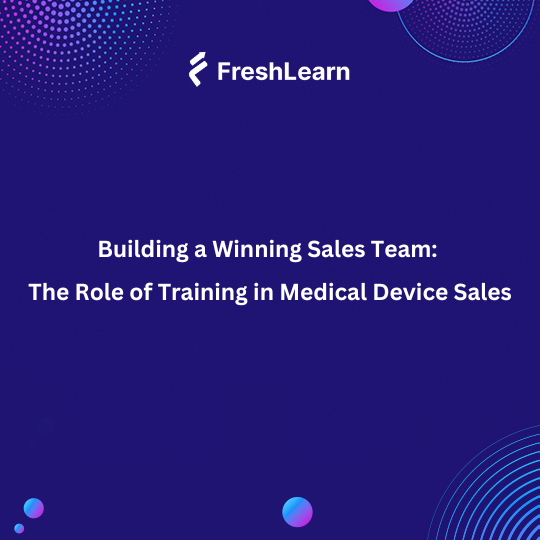
Building a Winning Sales Team: The Role of Training in Medical Device Sales
A well-trained medical device sales team has a thorough knowledge of healthcare sales, enough to interact with major stakeholders in the industry and drive device value. Given how competitive the healthcare market is, you can’t forego this training or afford to skimp.
After all, specialized training is what sets businesses apart and helps you gain an edge over your competitors. This blog will explore the importance of medical device sales training and what it takes to build a successful sales team. You’ll bolster your bottom line and forge a path toward growth.
The Importance of Medical Device Training
Onboarding new staff and getting your existing staff up to speed via medical device sales training is a decision that will benefit everyone. Here’s how.
1. Compliance with Regulations
The International Organization for Standardization or ISO produced quality management systems guidelines under its ISO 13485:2016 guide. The goal is to put forth the requirements for product cleanliness, preventive and corrective action verification, sterile medical device validation and documentation, implantable device traceability, and risk management.
Besides those standards, the FDA also has its own guidance documentation that establishes enforcement and inspection procedures, how it processes and evaluates submissions for approval, and how regulated products undergo proper design, manufacturing, testing, and labeling before they’re available for sale.
Training your team in these regulations ensures that all medical device sales your business offers are legal and can’t come back to haunt you later.
2. Ensuring Competence and Reducing Errors
Another reason to provide training is to lessen the risk of mistakes. For example, perhaps you give a medical product as a sample or gift to a prospect to try, which is considered a violation of the rules.
These kinds of egregious mistakes, even if done innocently, can land your business in some seriously hot water, eroding your reputation and consumer trust.
Key Benefits of Medical Device Training
Let’s peel back the layers further to evaluate even more advantages of requiring your team to participate in medical device training.
1. Improved Employee Performance and Morale
Medical device sales training can bolster your employees, enabling them to perform at their best. Throughout your training materials, you can identify which strengths your team has, and then unify those advantages to make an overall more operable team.
The goal here is to improve morale by making your employees feel more valued. Bringing the team together and ensuring the sum of its parts is strong will make each employee remember how they’re needed and appreciated.
Although medical device sales can be a tough job, you should notice a reduction in turnover as you prioritize employee satisfaction.
2. Addressing Staff Weaknesses
Of course, no sales staff is perfect, so you should be prepared to discover some weaknesses during the training program. Think of this positively, as it is advantageous. You can catch these issues now before they fester and limit sales later.
Besides that, you can also tailor the training to address the knowledge gaps you’ve found, making medical device education more fulfilling and rewarding for your employees.
They’ll feel more confident when they begin selling products, ensuring they can do their jobs efficiently. Ultimately, their reduction in mistakes can help your business close more deals and earn more customers and sales.
3. Enhancing Consistency and Uniformity
Another undeniable advantage of medical device training is how it lays down the ground rules. The training will create a baseline knowledge for all employees. Everyone will be on a level playing field, with uniformity in compliance with procedures and device usage.
Although competition can be smart sales strategies in some fields, it’s better to have all your employees on equal footing rather than pitting them against one another. This way, they can use their strength in numbers to eke out a profitable sales approach.
Components of an Effective Medical Device Training Program
Now that you’ve clearly seen why you should prioritize medical device sales training, you’re probably more eager than ever to implement your own training program. Hastening the development of a program can lead to gaps in employee education, so slow and steady will win this race.
Let’s examine the necessary components of a comprehensive training program.
1. Ongoing and Varied Training Methods
There is no reason for training sessions to go on longer than necessary. Most people can only concentrate on any material in front of them for 20 minutes max, and for some, it’s less time, only 15 minutes.
It’s in your best interest to limit the duration of your training sessions. Rather than have three or four hours-long, drawn-out training classes, break it down into seven or 10 shorter, snappier sessions.
The information will still be the same, but your presentation methods will differ. Data has shown that breaking the lessons down into chunks, known as the spacing effect, can benefit learning retention, efficiency, and reinforcement.
Keep the training continuous as well. Encourage your employees to schedule individual, peer-to-peer sessions as required after the training concludes to help with remember and retain the information they learned.
2. Competency Assessments
Although no one enjoys taking tests, they’re a valuable part of determining where gaps in your employees’ knowledge might exist that will make it harder for them to efficiently do their jobs.
The assessment doesn’t need to be graded, since this isn’t high school, but you should offer feedback to those employees who underperformed on the assessment so you can understand why.
Perhaps those employees need more training or a different level of training, such as one-on-one attention. You should provide example scenarios that show the most proficient usage of medical device testing to help reinforce concepts.
3. Comprehensive Coverage
Ensure your training materials cover every last aspect of using a medical device, including what each device is, any additional names or nicknames, and how to tell it apart from others. You should also go over what the device does, including basic and advanced functions.
Another important consideration is troubleshooting. A client will come to your team if their medical device malfunctions, so if your employees don’t know how to troubleshoot it, they can’t do an efficient job selling the product or assisting those who completed their purchases.
Methods of Delivering Training
By this point, you’re about ready to deploy your training plan, but you should first ensure you select the right methods according to these options:
1. In-Person and Peer Learning
Sitting in a classroom (or a spare hospital room) while an instructor leads a class among other sales peers is one method of learning, and arguably the most responsive. Instructors can get real-time feedback about whether employees are learning the concepts, and employees can also get more information in real-time by raising their hands and asking questions.
Plus, teaching in a classroom environment is an excellent way to minimize distractions. Making rules, such as turning one’s smartphone off during lessons, means all employees are paying attention.
2. eLearning and Virtual Instructor-Led Training (VILT)
Much more convenient is the concept of vILT or eLearning. This form of instruction requires everyone to log onto a computer or a mobile device to follow along with the class. Online learning offers more accessibility and flexibility in each training module.
Better yet, you can build the courses to suit the needs of various employee groups, tailoring the educational experience so each employee gets the full value.
Another perk of online learning is how efficient it is. People can learn in an environment that’s conducive and comfortable for them, which may maximize their ability to retain information.
3. Microlearning and Gamification
Gamification doesn’t always have to be competitive. Instead, by making the learning process fun, you’re more likely to help the employees pay attention and remember what they learned, which will be evidenced by their higher-scored assessments.
Microlearning is a concept where complex topics are deconstructed into smaller modules to suit everyone’s learning pace. You can use microlearning with online or in-class learning, so it’s a wonderfully versatile education option.
Real-World Impact of Medical Device Training
Let’s wrap up with a thorough examination of some of the top-led examples of medical device sales training and how it benefited brands in healthcare.
Case Studies and Examples
Summit Medical:
The UK-based Summit Medical produces infection control, sports medicine, and surgical products. However, its sales team lacked alignment, so the general manager decided to seek further education.
The tailored training the Summit team received was broken down into 12 modules spaced out across three months. Only 11 sales reps participated, and all the modules were interactive to maximize engagement and participation.
Two of the 11 sales reps began closing deals immediately after completing the course, and sales went up for Summit across the board.
Value-Based Purchasing and Reimbursement
While ponying up for professional training will cost your healthcare or manufacturing company initially, think of the decision as value-based purchasing. The education will have paid for itself when your team can sell more medical devices that improve the quality of healthcare your clients receive.
Moreso, there are financial incentives associated with higher-quality patient outcomes and using devices properly, both of which your team can ensure with the right training.
Conclusion
Medical device sales training plays a critical role in instructing patients on how to safely and effectively use these devices. Tailoring training to the needs of your team, including bridging their weak points and bolstering their strengths, will improve retention and confidence on the sales floor. In turn, that should reduce the rate of employee turnover.
Investing in comprehensive training programs is key to enhancing customer safety and satisfaction!



